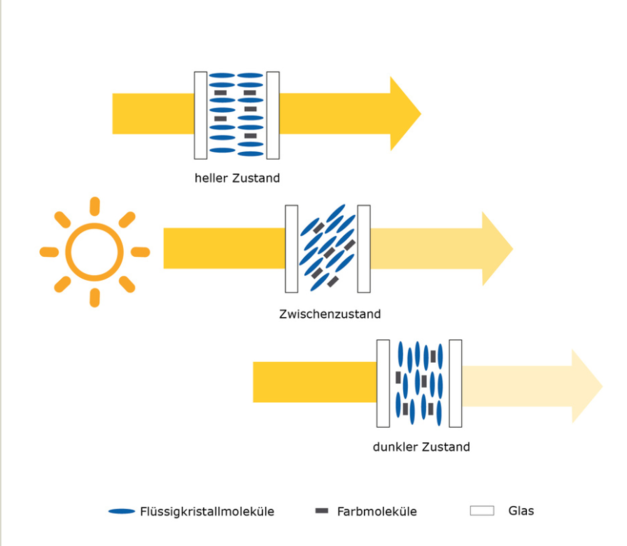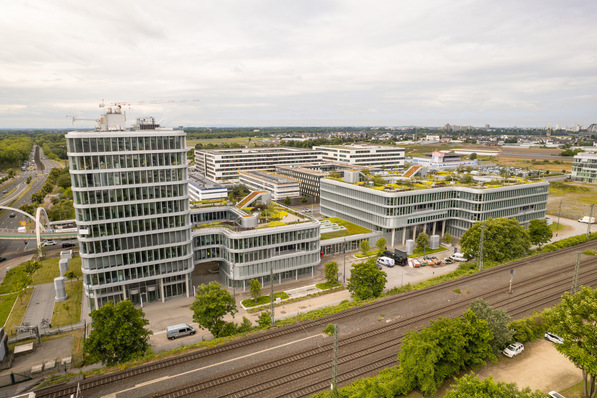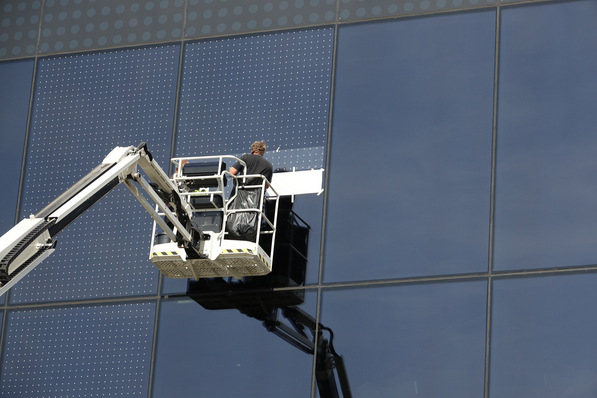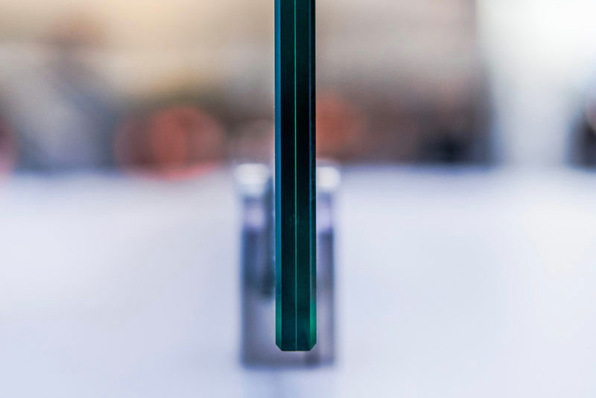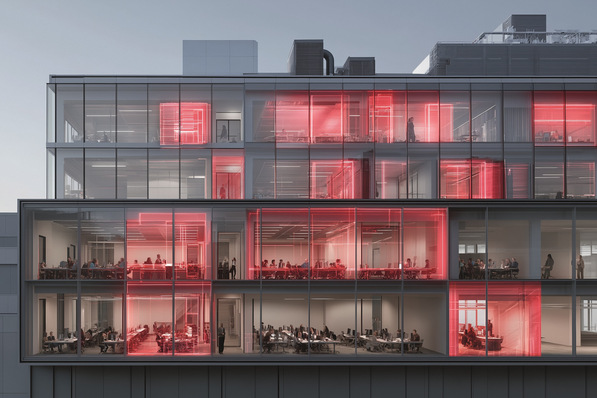Intelligent buildings and especially intelligent façade design are now regarded as an essential part of climate protection. In addition, more and more attention is being paid to the well-being and health of the people who spend time in them. Thus, dynamic or intelligent glass has become increasingly popular in recent years, as it offers greater flexibility in façade design compared to static solutions.
Glatt Tower refurbishment: New facade using smart glass
Switchable glasses that change their optical and thermal properties (e.g. variable g-value) when an electrical voltage is applied are being used more and more frequently. Used as solar control glasses, they can replace mechanical solar control systems such as roller shutters, roller blinds or interior venetian blinds. This saves space and helps reduce ongoing building maintenance.
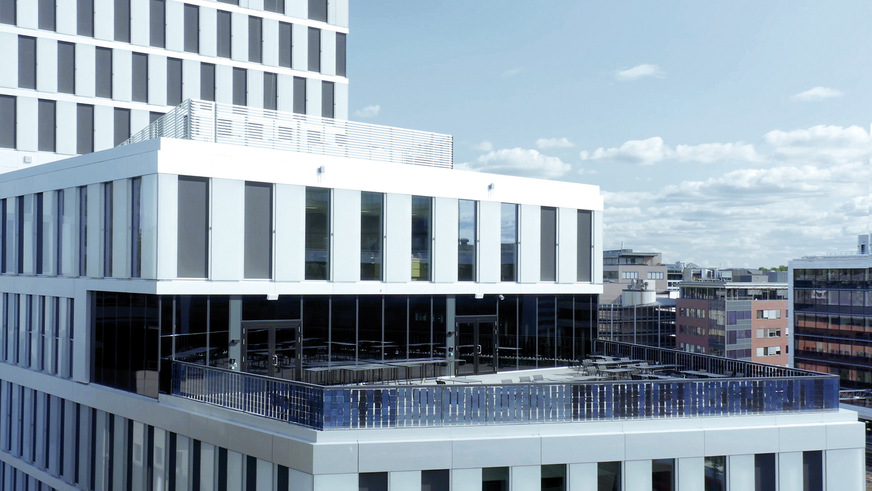
eyrise
Switchable solar control glasses, whose switchable element is based on liquid crystals, offer several advantages here. Thus, eyrise B. V., a subsidiary of the Darmstadt-based science and technology company Merck, has developed liquid crystal glasses of the same name whose light and heat transmittance can be regulated in seconds and continuously.
The eyrise s350 solar control variant is suitable for facade glass, while the eyrise i350 type, which can be switched from transparent to translucent, offers a visual protection solution for interior glazing. Applications include room dividers, privacy screens and projection screens.
How do Merck's eyrise liquid crystal glasses work?
The eyrise system is based on a liquid crystal technology developed and patented by Merck, which has so far been used primarily for flat screens or smartphone displays.
The basis is the transparent licrivision liquid crystal mixture, to which specific colour molecules can be added as desired. It is sandwiched between two sheets of glass that are coated with an invisible conductive layer. When a low electrical voltage is applied, the molecules in this liquid crystal cell change their orientation and thus influence the light and heat transmission of the glass (Fig. 01).
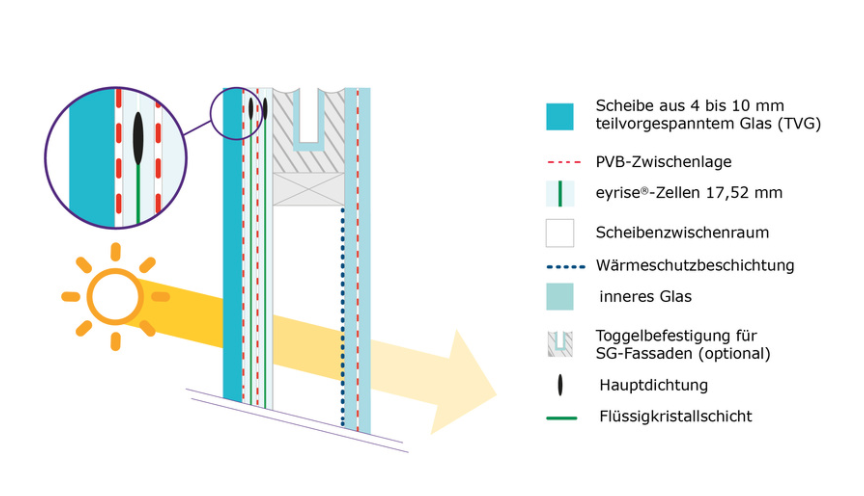
eyrise
The glass can be controlled via switches (manually) as well as via a smartphone app. In addition, the control can be integrated into the building management system.
Why do the eyrise glasses have very short switching times with neutral tint?
With conventional electrochromic solar control glass (EC glass), the switching process is based on a chemical reaction and takes several minutes. In addition, these glasses change colour as they darken, usually to blue.
With eyrise solar control glass, the switching of the liquid crystal molecules from maximum to minimum light transmission is a physical process that takes only about one second. Up to 256 intermediate steps are possible, so that light transmission and solar radiation, e.g. on cloudy days, can be sensitively adjusted to changing needs.
See also: More than 90 Lidl stores fitted with switchable glass
Due to the short switching times and because eyrise retains its neutral tint in every state, the switching processes are hardly perceptible to the people inside. Thus, an undistorted view to the outside is maintained at all times. In addition, the furnishings and objects inside appear in their natural colour.
What about the service life of the eyrise glasses?
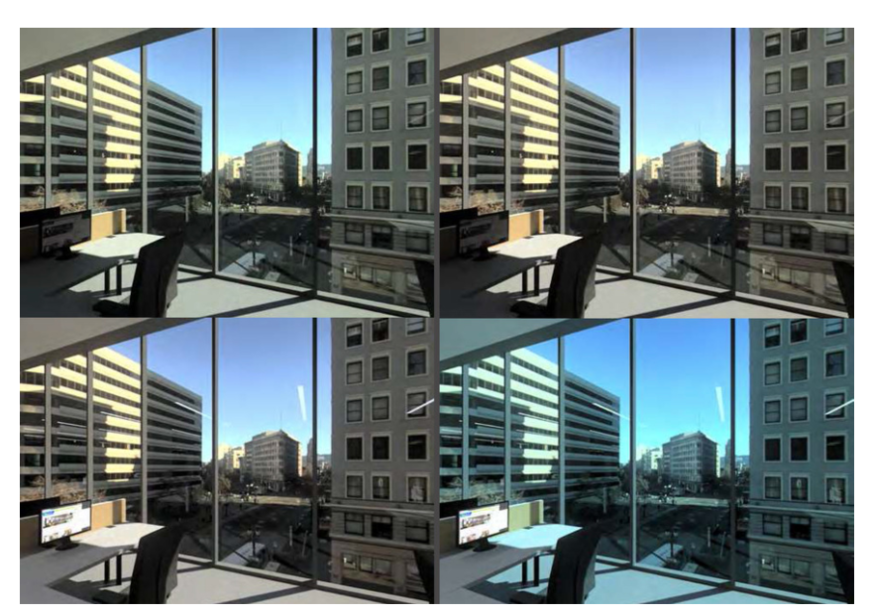
eyrise
According to the developers, the switching process can be repeated an infinite number of times without impairing the effectiveness of the sun protection. Therefore, liquid crystal windows have a very long service life.
See also this article: 6 ideas for great uses of glass in indoor spaces
The eyrise solar control glasses are designed as multi-pane insulating glasses. Picture 03 shows the typical structure of a 2-pane insulating glass unit. The outer pane is a laminate of 4 to 10 mm thick heat-strengthened glass (TVG) and two identical liquid crystal cells, each 17.52 mm thick. These three elements are each connected to each other via PVB interlayers. The inner pane is a heat-protective coated laminated glass.
High design freedom with high efficiency
Due to its colour neutrality and short changeover times, eyrise offers a very high degree of design freedom. The supplier manufactures the glasses in formats from 450 x 410 mm to 1600 x 3505 mm. In addition, different geometric shapes are possible.
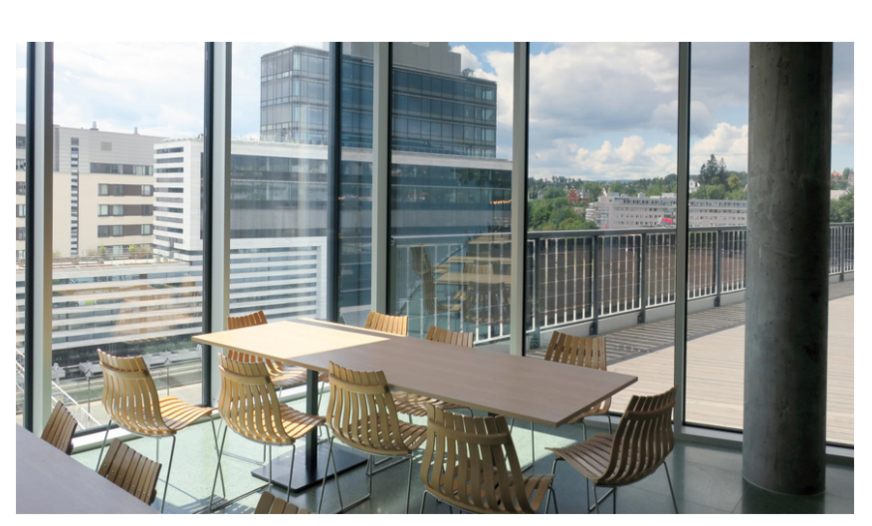
eyrise
On request, the liquid crystal mixture can also be individually coloured to meet special specifications of the building owner or architect. Thus, these intelligent glasses can be seamlessly integrated into traditional and modern architecture.
In terms of costs, eyrise is in the range of complex facade solar protection systems, as the supplier emphasises. In order to compare individual solutions with each other, a holistic approach is necessary. Compared to mechanical sun protection systems, eyrise's dynamic liquid crystal glasses do not require any maintenance, and they can be integrated into the façade in a space-saving manner, which has a positive effect on the utilisation of space, especially in tall buildings with many storeys. Corresponding calculations and comparisons as a basis for decision-making are part of the manufacturer's service.
How eyrise glass proves itself in practice
Architects and building designers all over the world already rely on eyrise to create customised glass structures and facades in a wide variety of shapes, sizes and colours. Examples include the Niemeyer Sphere in Leipzig, the new FC Group headquarters near Karlsruhe and Merck's conference centre in Darmstadt.
One of the first projects to be equipped with switchable eyrise glasses is an office building in Oslo. This was inaugurated in February 2019. The panes are used for the large-scale glazing of the cafeteria of the 16-storey Orkla City complex.
A total of 23 rectangular glass panes in a neutral grey colour were installed in seven different sizes for the 82 m2 glass front. The largest of these measures 1200 x 3300 mm. The darkening of the glass is automatically controlled by an external light sensor, but can also be readjusted by the user via the building management system if necessary (Fig. 04).
Why did the client choose the switchable eyrise glass?
The client, Orkla Real Estate, attached great importance to environmentally friendly and energy-saving technologies in this project. On the one hand, as much natural daylight as possible should enter the room - an important contribution to people's well-being during the long Norwegian winter. Secondly, glare and excessive heating of the room in the summer months by the sun, which is low on the horizon in the north, should be prevented in order to minimise the need for air conditioning.
See also: What you need to know about insulating glass spacers
Traditionally, buildings in these latitudes are very well insulated and therefore heat up more in summer, requiring appropriate ventilation or air conditioning systems to control the room temperature.
Gjert Brun, Managing Director at Orkla Real Estate, explains: "eyrise liquid crystal glasses enable intelligent control of light incidence and room temperature, while helping to reduce our energy costs."
Sources: [1] Elementa Consulting (2019), Out of the Blue - eyrise Dynamic Liquid Crystal Windows, London.







